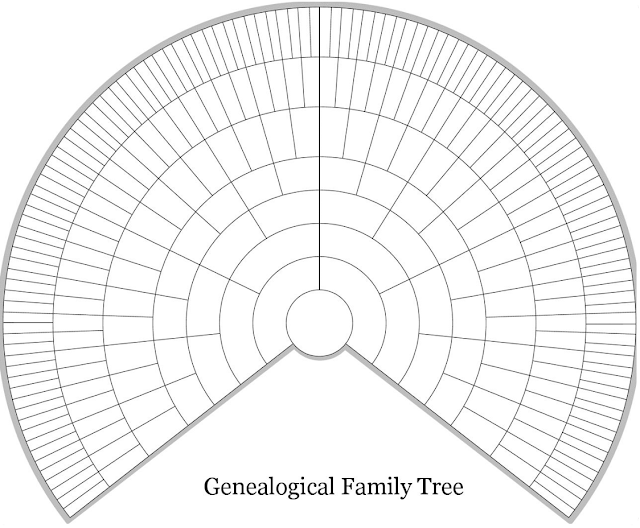What to Do When You Don't Know What to Do?
We've all been there. Lots of things to do, but .....
Stymied. This feeling signals to me that I need to clear the decks, clear up unresolved issues, and maybe chart the progress so far! I recently viewed a webinar by Blaine Bettinger on the genetic family tree compared to the ancestral tree. On a fan chart, the concept is quite clear, and you can see his images here: https://thegeneticgenealogist.com/2009/11/10/qa-everyone-has-two-family-trees-a-genealogical-tree-and-a-genetic-tree/
 |
| Pinterest.com |
Genetic Family Tree
I'm listening to a lecture by Tim Jantzen about using autosomal testing for ancestors into the 1700s, and he says,At 10 generations back in time, perhaps only about 12% of one's ancestors are contributors of autosomal DNA to your genome; only about 12 of your 1024 ancestors are your genetic ancestors. [1]
I think it is a worthy goal -- paint or otherwise triangulate DNA matches from as many ancestry lines as possible and denote them on a fan chart, and see where the DNA 'drops out' -- because if you do not share DNA from a descendant of an ancestor, then you probably do not have any DNA from the ancestor. Like any other genealogical finding, it is always subject to change if new data arrives, but it can be quantified.
Research Routine
Meanwhile, I decided this week to check all the obits that I've collected. Usual process is to:
- Find the obituary or other significant story, create an image by screenshot or if necessary, snipping
- Transcribe the obituary
- Post the image and transcription in the person's profile
- Link all people mentioned in the document
- Follow up if necessary by adding residence facts to the survivors
Use All the Tools
How does checking obits help my DNA research, you ask? In my opinion, DNA is one of the tools I use in my research. Newspaper research is another. I can't possibly move further in my DNA research when profiles are left unfinished, including the spouses and others to whom I am not related, because they are the parents of my cousins and other more distant DNA matches. Also, how do I know that I'm not related to them? I have found intermarriage in a few lines so far, and I won't be surprised when I find more. While doing some of this work, I might be getting closer to meeting the Genealogical Proof Standard (GPS). Of course, I'd like to meet that standard for every one of my ancestors eventually, but how do I know if I'm making progress?
Metrics
If you like measuring your progress, please check out this blog post, Six Levels of Ancestral Profiles – Level-up Challenge! by Yvette Hoitink: https://www.dutchgenealogy.nl/six-levels-ancestral-profiles/One of the images she uses to illustrate what this work of creating metrics does for your research envisions my hopes! I don't think I'll be creating this spreadsheet this year, but maybe 2022?

Feedback
Readers, do you have other ways of measuring your progress? Tell us!
1. tinyurl.com/TJFHF2021
 |
| Valorie Cowan Zimmerman |




Comments
Post a Comment